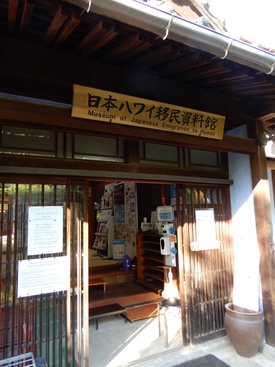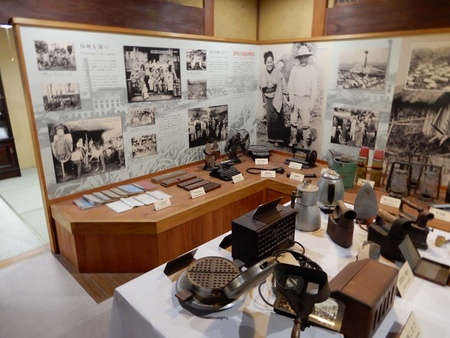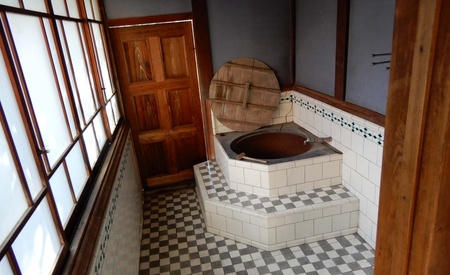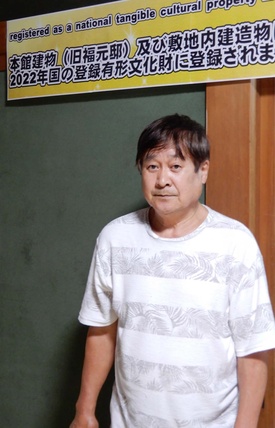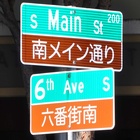The Seto Inland Sea is dotted with about 700 islands of various sizes, and Suo-Oshima (officially Yashirojima), located in the southeastern part of Yamaguchi Prefecture, is the third largest island, but it is here that the Museum of Japanese Emigration to Hawaii is located. During a trip to the Chugoku region, I visited the museum on an island that is also known as the "Hawaii of the Seto Inland Sea" for tourism purposes, to find out what it is like and why it was built here.
The museum is the home of successful people
Drive from National Route 188 across the Oshima Bridge to the island, then drive along the coast for a while before heading inland and you will see signs. Using these signs, you can continue to go left and right along narrow roads in the tranquil countryside, and finally arrive at the two-story wooden museum.
The reason why the museum is located in such a complicated place is that it was originally a residence built by a man named Fukumoto Choemon, who made a successful journey to America from this island during the Meiji period, after he returned to Japan in 1924 (Taisho 13), and the museum was built as is, hence the location. The building, which is estimated to have cost around 300 million yen in today's money, has a Japanese-Western hybrid feel, incorporating Western design elements into a traditional Japanese house.
During the Meiji period, many people from the island of Suo-Oshima immigrated to Hawaii, and this museum was opened in 1999 by the local town of Suo-Oshima (Suo-Oshima County, Yamaguchi Prefecture) to preserve that history for future generations.
Taking into account the history of Japanese immigration to America and Hawaii, the exhibition focuses on materials and explanations about the history and background of immigration from Suo-Oshima to Hawaii, as well as daily necessities brought back by people returning from Hawaii and photographs and materials showing the actual conditions of labor in Hawaii.
Other exhibits include the Fukumoto family, the achievements of immigrants, exchanges with Hawaii, and Japanese language education there. There is also a theater room that looks back on immigration through video, and a corner about immigration to Peru and Brazil.
There is also a search section where you can look up travel records of approximately 130,000 people who traveled from Japan to Hawaii, including both government and private immigrants.
Inside the building, the tiled bathroom from when it was used as a residence has been preserved, and is itself worth seeing. The building and the structures on its grounds are scheduled to be registered as a tangible cultural property of Japan in 2022.
The prominent Suo-Oshima
The museum, which uses the home of a successful immigrant, is an ideal place to learn about immigration from Japan to Hawaii, the history of immigration from the islands, and records of immigrant life that capture the local situation. The materials are well organized and well maintained.
Yamaguchi Prefecture, along with Hiroshima Prefecture and others, is known as an immigrant prefecture, but even so, why did such an extensive museum come to be established on this island?
Looking back at Japanese immigration to Hawaii, it began as a bilateral system between Hawaii and Japan. Hawaii needed foreign laborers to work on sugar plantations, and the Hawaiian government strongly requested that the Japanese government recruit immigrants as farm laborers. In response, due to the exhaustion of rural areas and the need to adjust the population, the Japanese government accepted the request, and in 1885, "kan'yaku migrant" began under an agreement between the two countries.
According to the museum, during this period of government-sponsored immigration, approximately 29,000 people were sent from all over Japan between 1885 and 1894, of which 3,913 were from Suo-Oshima, accounting for approximately 13.5% of the total - a remarkable number for one small island.
"The population is now around 15,000, but at the beginning of the Meiji period there were about 70,000. At that time, politics was in chaos, and there were also natural disasters such as typhoons, so the islanders could not make a living. At the same time, the island had a history of migrant workers, and it was common for people to go out on boats. At that time, the government talked about migrant workers (overseas emigration), and many people applied. For the islanders, it probably felt like going to a faraway place for a long period of time," says Makoto Kimoto, director of the museum.
But even so, surely there must have been many other regions that were in similar conditions to the people who wanted to emigrate because they were struggling to make ends meet. It is surmised that there must have been other reasons why immigrants from Suo-Oshima stood out, and Director Kimoto suggests that this may have been due to the influence of Inoue Kaoru, a politician in the Meiji government who was from Choshu.
"Before the Meiji Restoration, Inoue felt indebted to the doctors on Suo-Oshima for their help, and so he probably wanted to make Suo-Oshima a better place." He believes that among the many applicants for government-sponsored immigration, people from Suo-Oshima were given priority and many were selected.
Exchange with Hawaii
Suo-Oshima used to be made up of four towns, each of which had exchanges with Hawaii. Due to these relations, a sister island relationship was concluded with Kauai in 1963. After that, an exchange student system was established and young people went from Suo-Oshima to Kauai for agricultural training. As the exchange deepened, opinions grew that records of the immigrants should be preserved, and the construction of the museum was realized.
Over the past 10 years, the number of visitors has ranged from 3,500 to 4,000, including up to 400 people from Hawaii a year. When people from Hawaii who were interested in learning about their roots were given records of their ancestors' past visits to Hawaii by staff, they were happy to take them home.
On the other hand, many people who visit while sightseeing wonder, "Why is there a Hawaiian Emigration Museum here?" In general, many people visit for sightseeing, attracted by the "Hawaii of the Seto Inland Sea" and tropical atmosphere, but the museum plays a major role in learning about the relationship between the island and Hawaii, and the history of Japanese immigration.
* * * * *
★Japanese Emigration to Hawaii Museum ★
Opening hours: 9:30am to 4:30pm Closed on Mondays (or the following day if Monday is a public holiday)
Admission fee: 400 yen for adults, 200 yen for children. For more information, please contact the museum (0820-74-4082).
URL: www.towatown.jp/hawaii
© 2022 Ryusuke Kawai


